Supply Chain Problems Lead to COVID-caused Shortages
Nitashia Johnson for The New York Times
The empty shelves at a Target in Dallas last June show how unprepared stores were for the COVID-19 crisis.
November 8, 2021
In late 2020, the world saw shortages in a variety of products due to the COVID-19 pandemic and the repercussions in the context of the global supply chain. This has continued to influence daily life for everyday consumers, as well as transnational corporations.
The supply chain is the interconnected network of producers, suppliers, and distributors of different products. During early 2020, lockdowns shutdown shipping lanes and factories around the globe. Restarting the global supply chain proved increasingly difficult. The blockage of the Suez Canal for six days in late March this year slowed the process down even further.
Per Forbes, “The complex system that moves raw materials and finished products around the globe requires predictability and precision. Both had been lost.” Some of the major issues that created this loss of precision is a shortage of shipping containers and an increase in shipping costs and congestion in delivery hubs.
On the distribution side, the spread of COVID-19 has sidelined many of the workers vital for the transportation of goods. The shortage of both truck drivers and port workers has impeded the circulation of goods made at factories in Asia to western countries.
“Once offloaded at ports, goods languish for up to two weeks because there aren’t enough drivers to transport them,” said Oren Klachkin, the lead U.S. economist for Oxford Economics in a recent report. “Pre-pandemic, a typical wait was three to four days.”
This disruption in the supply chain is the root cause for many of the shortages around the world. Examples of major shortages are healthcare supplies including oxygen and PPE equipment, computer chips, food products, and labor. COVID-19 increased the need for medical protection equipment, but the broken supply chain is unable to provide what is necessary.
Perhaps the shortage with the most far-reaching consequences, computer chips are necessary for many of the machines involved in the supply chain. Production of these chips slowed significantly due to the pandemic, and cannot yet work fast enough to make up for the loss. Car factories in many countries have had to shut down their assembly lines, which has, in turn, resulted in a shortage of delivery trucks. This has only compounded the issues in the production and distribution chain.
Per the New York Times in an article about the recent shortages, “By the time they realized that demand was reviving, it was too late: Ramping up production of computer chips requires months.”
The chief executive of intel, Pat Gelsinger, predicts the shortage of computer chips will get worse in the second half of this year, and it will be a year or two before supplies return to normal.
Labor shortages are now widespread and affecting nearly every part of day to day life. The loss of labor due to COVID impacts a country’s economy as a whole, but it also influences life within North Allegheny. The school district is facing a shortage of cafeteria workers, custodians, and bus drivers. Current workers are forced to overextend themselves to do jobs meant for a greater number of people.
These shortages and issues in the supply chain will not be fixed anytime soon. With the upcoming holiday season and the continued outbreaks of COVID-19, distribution will continue to have severe delays.













RF • Nov 10, 2021 at 10:40 pm
Lots of information and complex interaction well presented. Good job, Claire. What’s your take, will Santa get enough presents together under those circumstances?